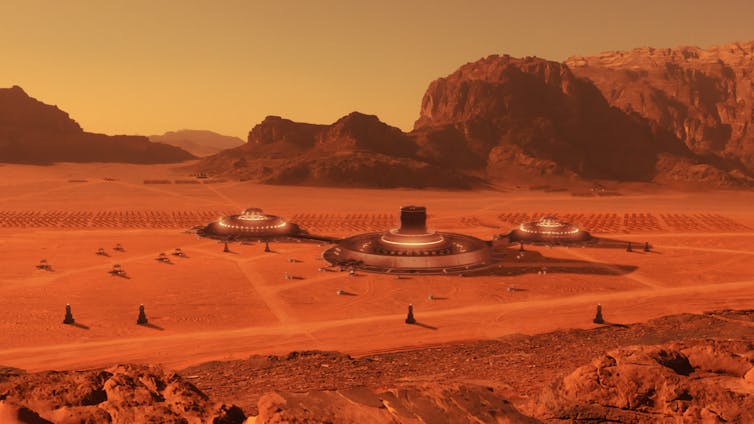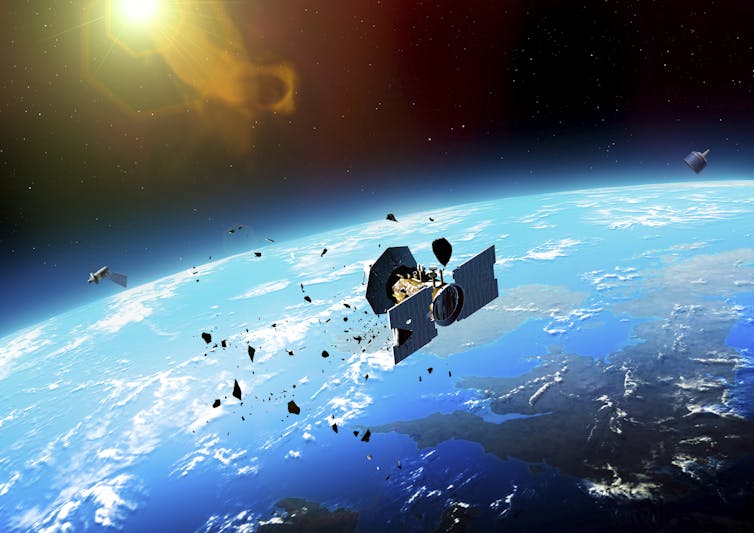
gremlin/iStock via Getty Images Plus
Mary-Jane Rubenstein, Wesleyan University
The past decade has seen a rapid expansion of the commercial space industry. Rival nations are competing for prime military and economic positions beyond the Earth. Public and private entities are clamoring to mine the Moon, and a growing halo of space junk is polluting low Earth orbit.
In a 2023 white paper, a group of concerned astronomers warned against repeating Earthly “colonial practices” in outer space. But what’s wrong with colonizing space if there’s nothing there to begin with?
I am a philosopher of science and religion who has been writing about the space industry for several years. As government agencies and private companies turn their eyes toward the stars, I’ve noticed many of the factors that drove European Christian imperialism between the 15th and 19th centuries reappearing in high-speed, high-tech forms.
Some of these colonial practices might include the enclosure of land, the exploitation of environmental resources and the destruction of landscapes – in the name of ideals such as destiny, civilization and the salvation of humanity.
Many space industry leaders, such as Mars Society President Robert Zubrin, argue that although European-style colonialism may have had unsavory consequences on Earth, it is the only way to proceed in outer space. In fact, he warns, any attempt to slow down or regulate the space industry will make the Martian frontier inaccessible to humanity, leaving us stuck on an increasingly dull and decadent Earth.

janiecbros/E+ via Getty Images
Zubrin has argued against concerns about colonialism in space. Unlike the Earth, outer space is empty, he claims. Why should anyone care about the rights of rocks and a few hypothetical microbes? But as it turns out, not everyone agrees that outer space is empty. And as the concerned astronomers have argued, abandoning the colonial playbook would benefit industry insiders and outsiders alike.
Is space really empty?
People of Bawaka Country in northern Australia have told the space industry that their ancestors guide human life from their home in the galaxy, and that this relationship is increasingly threatened by large orbiting satellite networks.
Similarly, Inuit elders say their ancestors live on celestial bodies. Navajo leadership has asked NASA not to land human remains on the Moon. Kanaka elders have insisted that no more telescopes be built on Mauna Kea, which Native Hawaiians consider to be ancestral and sacred.
These Indigenous positions stand in stark contrast with many in the industry’s insistence that space is empty and inanimate.
The key to reconciling these vastly different positions is to seek agreement – not on beliefs or worldviews, but rather on behavior. Secular space enthusiasts do not need to agree that outer space is populated, animate or sacred in order to treat it with the care and respect Indigenous communities are requesting from the industry.
Treating outer space with care might involve preserving noteworthy natural formations, limiting mining, cutting back on satellite permits and launches and figuring out a way to clean up garbage in orbit.
Environmental concerns
The emerging field of space ecology examines the relationships between human artifacts and natural environments in the context of Earth’s orbit, on the Moon and on other planets. As this discipline seeks to demonstrate, orbits and planetary bodies are delicately balanced systems.
Without consistent regulation, commercial space activity could render orbits unusable and throw off the Moon’s vacuum-like atmosphere.
In fact, the light bouncing off careening space junk – defunct satellites, pieces of spacecraft, cellphones, nuts, bolts, shards of metal and glass – can prevent astronomers from seeing, photographing and navigating by means of the stars.

Mark Garlick/Science Photo Library via Getty Images
The Moon, Mars and asteroids help scientists understand how planets and the solar system formed, what conditions are necessary for life and what planets might look like in the future. If the space industry blasts, mines and – following a suggestion from SpaceX CEO Elon Musk – nukes planetary bodies, scientists could lose access to this knowledge.
The commercial space industry has already done significant environmental damage on and around Earth.
SpaceX’s constant rocket tests and launches have decimated the wetlands of Boca Chica, Texas. A SpaceX Starship explosion in April 2023 damaged an estimated 385 acres of land, waterways, turtles and birds – not to mention cars, houses and human lungs.
The industry’s rocketing number of private and public launches deposit kerosene, carbon and sulfur into the upper atmosphere, where these substances remain longer than they do in the stratosphere.
Research has shown that the accumulation of these substances could escalate climate change exponentially. By one estimate, rocket emissions heat the atmosphere 500 times as quickly as aviation emissions.
Even if Musk never makes it to Mars, SpaceX and a throng of competitors are creating satellite traffic in low Earth orbit that can threaten astronauts’ lives and risks making these orbits unusable.
Human consequences
Many space industry leaders celebrate space as the new New World or the final frontier. But the early modern economies in sugar, tobacco and gold generated empire-building profit for Europe and the early U.S. by means of enslavement and indentured servitude.
Space industry leaders will have to consider what labor arrangements will look like as they send workers to staff their hotels, build their bunkers and facilitate asteroid mining. After all, space workers will rely on their employers not only for a paycheck and health care, but also for food, water, air and transportation back to Earth.
In 1967, a slew of nations including the U.S., U.K. and USSR, signed the Outer Space Treaty. This treaty declared, among other things, that no nation can own a planetary body or part of one.
Negotiated and signed in the wake of two world wars, the Outer Space Treaty was a product of conflict in Europe in the 20th century. If colonialism on Earth culminated in these two wars, the nations that signed the Outer Space Treaty were effectively saying, “Let’s not battle each other for territory and resources again. Let’s do outer space differently.”
At this point, the Outer Space Treaty has become outdated and all but unenforceable. But any future legislation would do well to retain the anticolonial spirit of the original treaty.
From a policy perspective, then, it doesn’t matter whether space is actually inhabited or whether rocks have rights. Preventing colonialism in outer space doesn’t require the space industry to agree on these metaphysical questions.
Instead, it will require participants across and beyond the industry to agree on a shared set of standards for caring about planets and their orbits – whether their motivations are scientific, environmental, humanistic or religious.
Mary-Jane Rubenstein, Dean of Social Sciences, Professor of Religion and Science and Technology Studies, Wesleyan University
This article is republished from The Conversation under a Creative Commons license. Read the original article.






























































